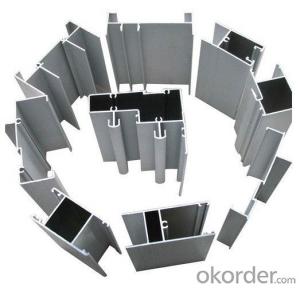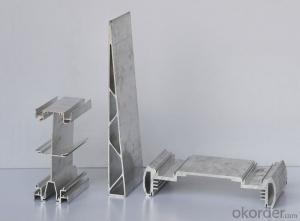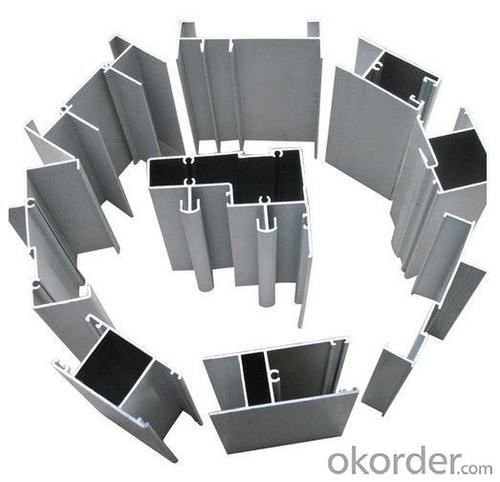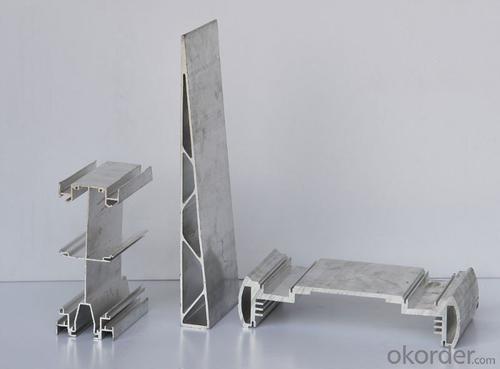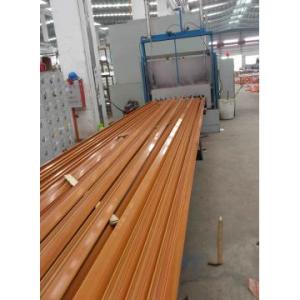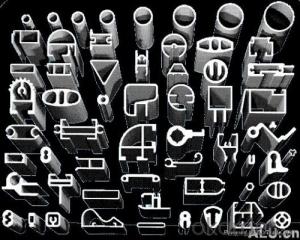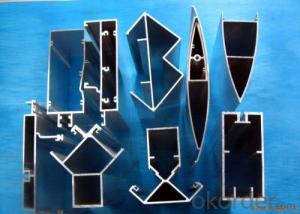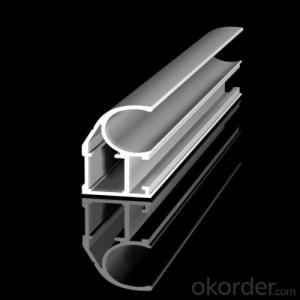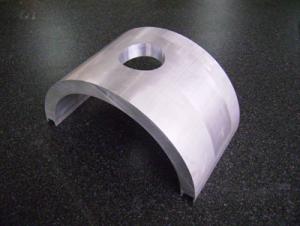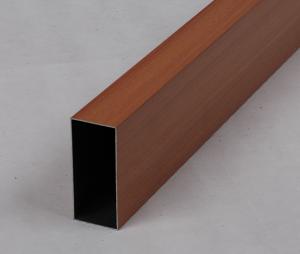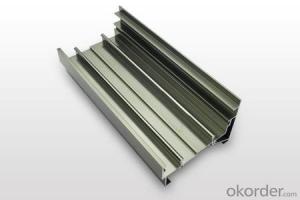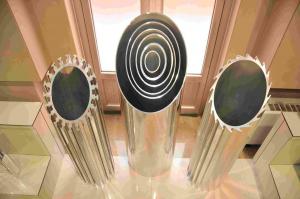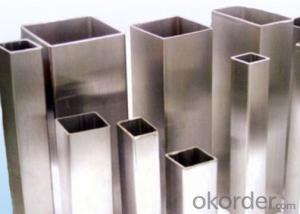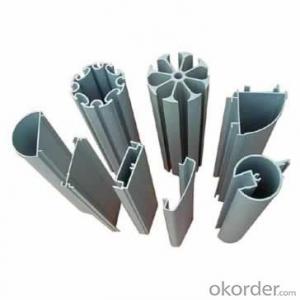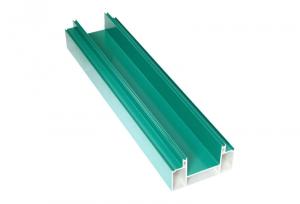Aluminum Profiles - Extruded Aluminum Profiles Made in China Prices
- Loading Port:
- Shanghai
- Payment Terms:
- TT OR LC
- Min Order Qty:
- 1 m.t.
- Supply Capability:
- 1000 m.t./month
OKorder Service Pledge
OKorder Financial Service
You Might Also Like
Specification
1. Specification of Extruded Aluminum Profiles Made in China Prices
Alloy | State | Tensile Strength δbMpa | Non-proportional Stretching Stress(δp0.2Mpa) | Stretching rate (δ%) | Pattern Thickness (mm) | HV | HW |
No Less Than | |||||||
6061 | T4/T6 | 180/265 | 110/245 | 16/8 | - | - | - |
6063 | T5/T6 | 160/205 | 110/180 | 8/8 | 0.8/- | 58/- | 8/- |
6063A | T5/T6 | 200,190/230,220 | 160,150/190,180 | 5,5/5,4 | 0.8,0.8/-,- | 65,65/-,- | 10,10/-,- |
2. Application of Extruded Aluminum Profiles Made in China Prices
wall cladding, ceilings, bathrooms, kitchens and balconies, shutters, doors,windows…
3. Feature of Extruded Aluminum Profiles Made in China Prices
Surface Quality :
Be free from Oil Stain, Dent, Inclusion, Scratches, Stain, Oxide Decoration, Breaks, Corrosion, Roll Marks, Dirt Streaks and other defect which will interfere with use,
Mochenical Property:
Chemical Composite and Mechanical Property
4. Certificate:
SGS and ROHS(if client request, paid by client), MTC(plant provided), Certificate of Origin(FORM A, FORM E, CO), Bureau Veritas and SGS (if client request, paid by client), CIQS certificate
5. Image of Extruded Aluminum Profiles Made in China Prices
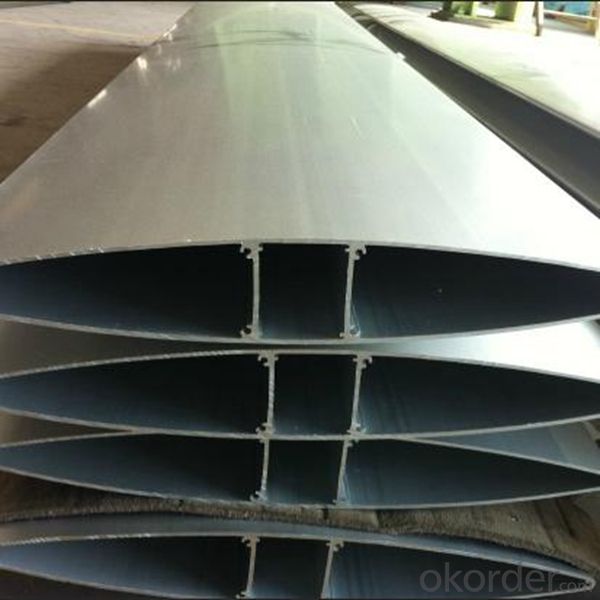
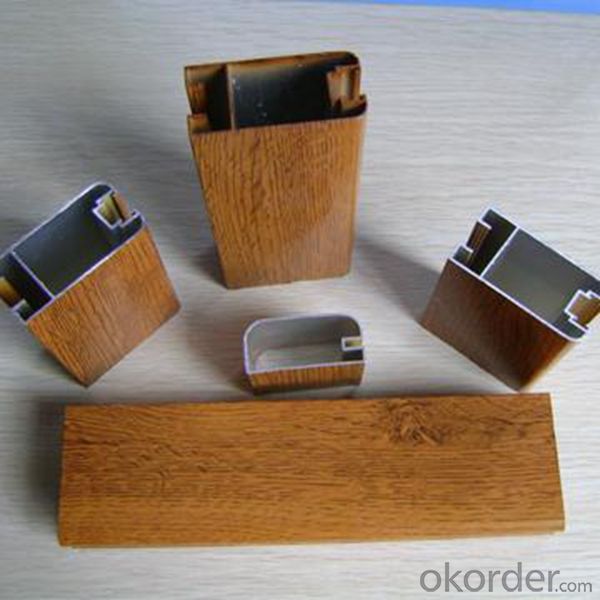
6. Package and shipping of Extruded Aluminum Profiles Made in China Prices
First, plastic cloth with drying agent inside; Second, Pearl Wool; Third, wooden cases with dry agent, fumigation wooden pallets, aluminum surface could cover blue PVC film
7. FAQ
Question 1: What is your MOQ?
We accept one ton per type for an order. But the detail we could negotiate.
Question 2: What is your normal terms of payment?
We always trade with you by T/T. But we also accept the L/C as you require.
Question 3: How many kinds of the surface treatment we can choose?
You could choose different color of powder coated. Anodized of black. matte silver, nature, champagne, bronze color. Mill finished. Wooden finished and printed.etc.
Question 4: Can you supply OEM services?
We offer OEM services for 17 years.
Question 5: How many days for opening the mould?
Normally about 10 days.According to the difficulty of your drawing.
Question 6: Can i choose the package what i want?
Yes, of course. We offer various kinds of package.e.g.PE foam. Shrink film. Wrapping paper.
But we would give you professional suggestion of package.
- Q: Are there any regulations or standards that aluminum profiles must meet?
- Yes, aluminum profiles must meet various regulations and standards. These include ASTM International standards, which provide guidelines for the composition, mechanical properties, and dimensional tolerances of aluminum profiles. Additionally, aluminum profiles may need to comply with specific industry and regional regulations, such as those set by the International Organization for Standardization (ISO) or the European Committee for Standardization (CEN). These regulations and standards ensure the quality, safety, and compatibility of aluminum profiles across different applications and markets.
- Q: What is the material content of 4040 aluminum alloy profiles?
- Aluminium alloy grade: 6063Silicon (Si) 0.2-0.6%,Iron (Fe) 0.35%,Copper (Cu) 0.1%,Manganese (Mn) 0.1%,Magnesium (Mg) 0.45-0.9%,Chromium (Cr) 0.1%,Zinc (Zn) 0.1%,Titanium (Ti) 0.1%Other metals accounted for 0.15% of the total,Aluminum (Al) 97.35--98.35%Shanghai Australia Hong Industrial Aluminum Co., Ltd. specializes in providing1. mold development and design2. extrusion of industrial aluminum extrusions3. industrial aluminum parts4. industrial aluminum profiles and assembly lines, tables, transmission line equipment development and installation
- Q: How much is the 5000 ton aluminum profile extrusion machine? What section can I have?
- 5000 tons press, plus auxiliary machine, installed finished, almost 50 million -1 million, this depends on the configuration. Cheap certainly also domestic, but a penny a cent goods.A general can reach the maximum about 400mm.
- Q: This question asks about the variety of colors offered for aluminum profiles used in exterior siding and trim applications.
- <p>Aluminum profiles for siding and trimming are available in a wide range of colors to suit various architectural styles and design preferences. Common colors include white, black, brown, beige, and gray, which are popular for their neutrality and versatility. Additionally, there are bolder options such as red, blue, green, and yellow for more distinctive looks. Some manufacturers also offer custom color matching services for specific projects. The finishes can be powder-coated or anodized, providing durability and resistance to weathering. It's always best to check with specific manufacturers for the most up-to-date color offerings as they may introduce new colors or discontinue others based on market trends.</p>
- Q: What are the various types of connectors that can be used with aluminum profiles?
- <p>Aluminum profiles can be connected using a variety of connectors designed for different applications and structural needs. Common types include: 1. T-slots connectors, which slide into the T-slots of the profiles for secure attachment. 2. Angle connectors, used to join profiles at right angles. 3. Corner brackets, for creating 90-degree corners. 4. Clamping blocks, which hold profiles together without screws. 5. Hinges, allowing for pivoting movements. 6. End caps, to cover the ends of profiles. 7. Cylindrical connectors, for joining round tubes. 8. Linear connectors, for straight-line connections. 9. Specialized connectors for specific applications, such as cable management or mounting brackets. These connectors are crucial for assembling aluminum profile systems in various configurations.</p>
- Q: This question asks about the various types of insulation panels that utilize aluminum profiles in their construction.
- <p>Insulation panels made from aluminum profiles come in several types, each with specific characteristics and applications. These include: 1. Sandwich Panels, which consist of two aluminum sheets with a core material like polyurethane, rockwool, or polystyrene. 2. Composite Panels, which combine aluminum with other materials for enhanced properties. 3. Structural Insulated Panels (SIPs), used in construction for their thermal efficiency and strength. 4. Cold Storage Panels, designed to maintain low temperatures in refrigeration units. 5. Acoustic Insulation Panels, which reduce noise transfer. Each type is chosen based on the required thermal, acoustic, and structural performance.</p>
- Q: This question asks for an explanation of various methods used to manufacture aluminum profiles, which are long, extruded shapes made from aluminum.
- <p>Aluminum profiles are manufactured using several processes, primarily extrusion, but also including casting, rolling, and machining. Extrusion is the most common method, where aluminum is heated and forced through a die to create a desired shape. Casting involves pouring molten aluminum into molds to form specific profiles. Rolling is used to produce flat sheets or plates, which can then be further processed. Machining involves cutting and shaping aluminum using tools like lathes and mills. Other processes include forging, which deforms aluminum under high pressure, and powder metallurgy, where aluminum powder is compacted and sintered into a solid profile. Each process has its advantages and is chosen based on the desired profile shape, strength, and application.</p>
- Q: How do you prevent galvanic corrosion when combining aluminum profiles with other metals?
- To avoid galvanic corrosion when combining aluminum profiles with other metals, there exist several effective measures that can be implemented: 1. Opt for compatible metals: Choose metals that are closely ranked in the galvanic series to minimize the potential difference between them. This decreases the likelihood of galvanic corrosion. For instance, utilizing stainless steel or titanium alongside aluminum can be a wise decision. 2. Insulate the metals: Employ insulating materials, like non-conductive coatings, paints, or tapes, to establish a barrier between the aluminum and other metals. This prevents direct contact and hinders galvanic corrosion. 3. Employ protective coatings: Administer protective coatings, such as anodizing or powder coating, to the aluminum surface. These coatings serve as a protective layer, preventing direct contact between the aluminum and other metals, thereby reducing the risk of galvanic corrosion. 4. Utilize isolating washers or gaskets: When fastening aluminum profiles to other metals, employ isolating washers or gaskets composed of non-conductive materials like rubber or plastic. These washers or gaskets create a barrier between the metals, thus preventing galvanic corrosion. 5. Consider design: Construct the structure in a manner that minimizes the potential for water or moisture accumulation between dissimilar metals. Adequate drainage and ventilation can help decrease the chances of galvanic corrosion. 6. Regularly maintain and inspect: Carry out routine inspections to promptly identify any signs of galvanic corrosion. If corrosion is detected, take appropriate action to rectify the situation, such as replacing damaged components or applying protective coatings. By adhering to these preventive measures, the risk of galvanic corrosion can be significantly diminished, ensuring the longevity and performance of the combined aluminum profiles and other metals.
- Q: The question asks if aluminum profiles can be tailored to fit particular specifications or needs.
- <p>Yes, aluminum profiles can be customized to meet specific requirements. This customization can include altering the length, shape, thickness, and surface treatment of the profiles to fit the needs of various applications. Manufacturers often offer a range of standard sizes and finishes, but they can also create bespoke profiles through processes like extrusion, cutting, and bending. Customization allows for the creation of precise fits and functional designs tailored to individual projects, enhancing both aesthetics and performance.</p>
- Q: What are the electrical insulation properties of aluminum profiles?
- Aluminum profiles have relatively poor electrical insulation properties. Aluminum is a good conductor of electricity, meaning it allows the flow of electric current. However, aluminum profiles can be anodized or coated with insulating materials to enhance their electrical insulation properties.
Send your message to us
Aluminum Profiles - Extruded Aluminum Profiles Made in China Prices
- Loading Port:
- Shanghai
- Payment Terms:
- TT OR LC
- Min Order Qty:
- 1 m.t.
- Supply Capability:
- 1000 m.t./month
OKorder Service Pledge
OKorder Financial Service
Similar products
Hot products
Hot Searches
Related keywords
